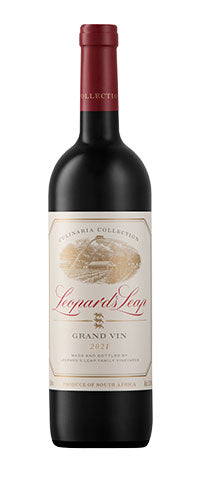

2021 Culinaria Grand Vin
R 165.00
excludes shipping
Grand Vin is a Bordeaux-style blend with complex layers. Aromas of red fruit, subtle black whiffs of cassis with integrated Tobacco and a hint of cedar, perfectly rounded with a fruity mulberry in the after-taste. The ripe tannins ensure a firm, elegant structure. A sincere wine that will complement well-prepared red meat dishes.
| Variety: | The blend consists of Cabernet Sauvignon (50%), Merlot (30%), Malbec (10%), and Petit Verdot (10%). |
| Character: | Grand Vin is a full-bodied Cabernet Sauvignon based Bordeaux-style blend with complex layers of fruit and oak. Aromas of black fruit, subtle black whiffs of cassis with integrated Tobacco and a hint of cedar, perfectly rounded with a fruity mulberry in the aftertaste. The ripe tannins ensure a firm yet elegant structure. A sincere wine that will complement well-prepared red meat dishes. |
| Vineyards: | Top blocks were identified in Stellenbosch, Darling and Botrivier to source the best grapes that will best fit the style of this unique Bordeaux wine. The vineyards used, consist of Cabernet Sauvignon grapes, grown on unirrigated bush vines in the Darling area, as well as Cabernet Sauvignon in Stellenbosch on slopes facing False Bay. The grapes are exposed to the cool sea breeze that contributes to a longer ripening period, enhancing flavour development. The Merlot comes from Stellenbosch area and the Malbec grapes are grown in Botriver. Petit Verdot grapes where sourced from Durbanville. Well-drained soil types and cool, southfacing slopes, unexposed to direct afternoon sunlight, create ideal growing conditions for these varieties. |
| Origin: | Culinaria Grand Vin is a Wine of Origin Western Cape. Grapes for the production of this classic Bordeaux-style blend originate mainly from the Stellenbosch and Darling areas. |
| Wine-making: | Grapes were hand-picked and hand-sorted. The varieties were harvested separately at optimal ripeness and at an average of 24.5 degrees Balling. Each variety was fermented separately at between 24 and 26 degrees Celsius. During winemaking there was minimal intervention, with regular punch-downs and pump-overs, for extraction of colour and flavour. After fermentation the grapes were pressed and malolactic fermentation was completed in 225-litre French oak barrels. 20% of the maturation took place in first-fill French oak barrels, and the remainder in second- and third-fill barrels. The components were kept separately for 16 – 18 months. Thereafter, blending took place, followed by bottling of the wine 3 months later. |
| Download Tasting Note PDF | |
5.8 g/l
14.37%
3,61
2.6 g/l


